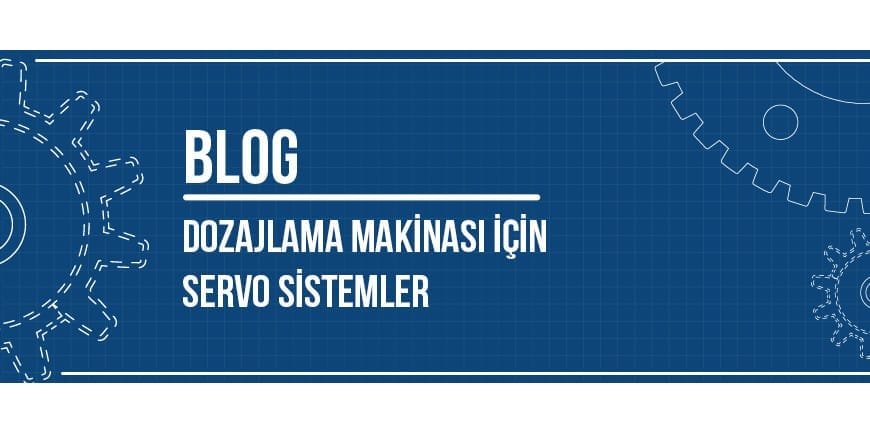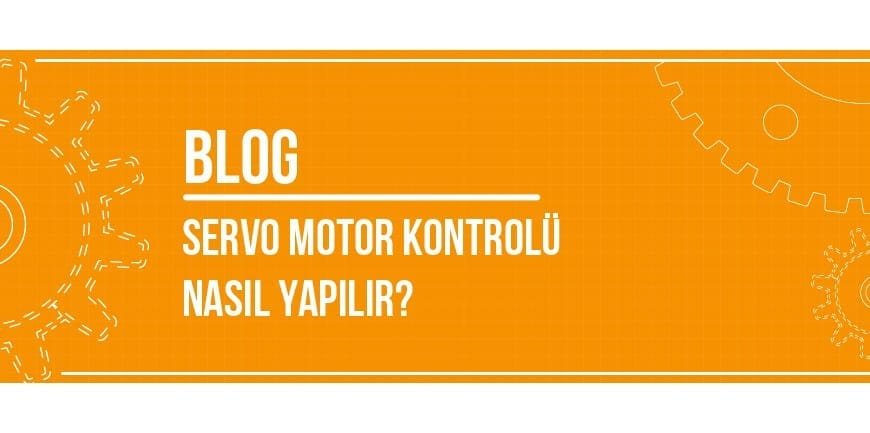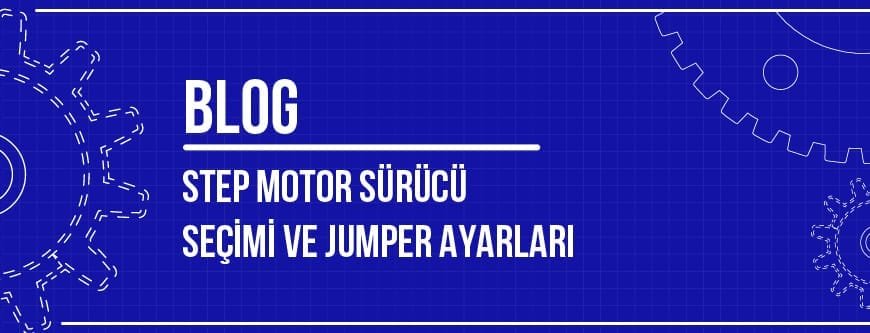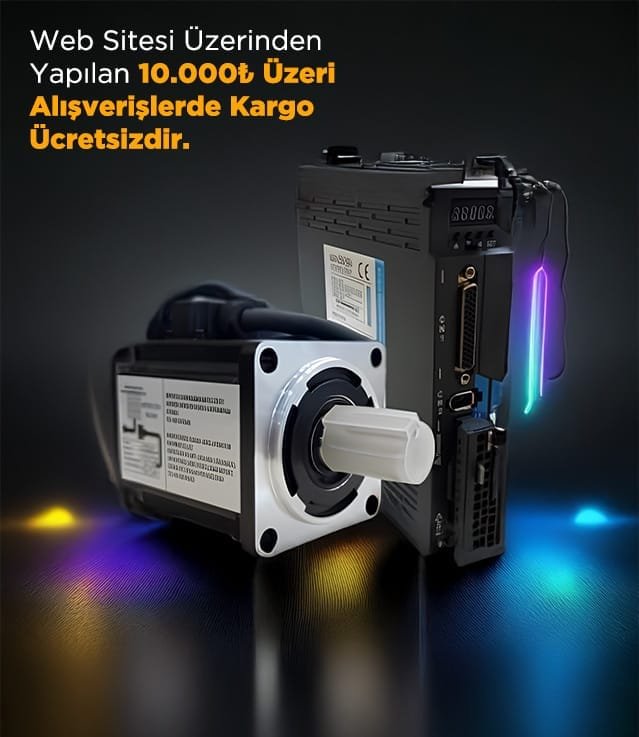
İçindekiler
Servo Systems for Dosing Machines
Dosing machines, which help to accurately measure and distribute materials such as liquids, powders, or granules, provide many benefits in the industrial field. You can learn about the servo motors used in dosing machines. We wish you all a good day and happy reading.
Why Should Servo Motors Be Preferred in Dosing Machines?
The main reason for choosing servo motors in dosing machines is that they provide high precision and control, ensuring consistency in dosing operations. For this reason, servo motors are equipped with feedback mechanisms, allowing them to continuously monitor and adjust the position and speed of each movement. This makes servo motors ideal for precise applications requiring dosing at the microliter or milliliter level.
In addition, servo motors can easily adapt to different dosing quantities and operate within a wide speed range thanks to their fast response times and high torque capacities. This allows for different dosing settings to be made with a single machine when processing various products. Furthermore, servo motors stand out for their durable construction, which requires less maintenance compared to other motor types, enabling longer-term, uninterrupted operation with fewer breakdowns and downtime in dosing machines.
What is the role of servo systems in dosing machines?
Servo systems play an important role in increasing precision, control, and efficiency in dosing machines. These systems operate with high precision to ensure that the required amount is dispensed accurately and consistently during the dosing process. In this context, servo systems guarantee the accuracy of the dosing process by continuously monitoring the position, speed, and torque values of each movement through feedback mechanisms.
Servo systems equipped with encoders and other feedback sensors control every step of the motor and make quick corrections to any possible deviations. This ensures that the dosed material is accurate in terms of quantity and speed. Additionally, the fast response characteristics of servo systems enable precise control of material flow during the dosing process. This is particularly critical in industries such as pharmaceuticals, food, and chemicals.
What are the components of servo systems in dosing machines?
There are certain key components used in servo motors for dosing machines. These components ensure a precise and efficient dosing process. The components of servo systems used in dosing machines are as follows:
- Servo Motor: Servo motors are generally the main power source of the system and provide the movement required for the dosing process. In this context, servo motors play a critical role in the dosing process thanks to their ability to perform precise positioning and speed control.
- Servo Driver: Servo drivers are used to control servo motors and process motion commands. They adjust the speed, direction, and torque of the motor to provide motion that meets the requirements of the dosing process. In this way, they instantly adjust the system by receiving feedback data from the motor.
- Encoder: Known as a sensor that provides a feedback system, encoders accurately measure the rotation angle and position of the motor, continuously monitoring the motor’s movements and transmitting position, speed, and direction information to the driver. This is necessary to ensure accuracy and repeatabi
- Feedback Sensors: Feedback sensors working in conjunction with encoders monitor the instantaneous status of the motor and provide information to the driver. This ensures that the motor operates in the correct position and any possible deviations are corrected.
- Control Unit: A central unit that manages the servo system and works in an integrated manner with the automation system of the dosing machine. In this regard, control units manage the dosing process by sending commands to all components and optimize the overall performance of the system.
- Connection and Cable Systems: Cable and connection systems that connect the servo motor, driver, encoder, and control unit to each other ensure fast and reliable data transmission. These connections must be checked regularly to ensure uninterrupted operation during the dosing process.
What Advantages Do Servo Systems Offer to Dosing Machines?
Servo systems offer many advantages to dosing machines. These advantages include precision, speed, and overall efficiency. Let’s take a closer look at these advantages:
- High Sensitivity and Accuracy: Servo motors precisely control position, speed, and torque thanks to their feedback mechanisms. This feature ensures error-free results even when dispensing at the microliter and milliliter levels, minimizing the margin of error.
- Repeatability: Servo systems offer consistency with their ability to deliver the same amount in every dosing operation. This repeatability is particularly important in industries such as pharmaceuticals, food, and chemicals, as it ensures precise and consisten
- High Speed and Control Capability: Servo motors enable fast dosing operations with their rapid acceleration and deceleration capabilities. In addition, the system’s ability to make instant adjustments allows the dosing speed to be easily controlled and stopped immediately when needed.
- Energy Efficiency: Servo systems optimize energy consumption by using only the energy required. This feature reduces the overall energy costs of the dosing machine, ensuring a sustainable working environment.
- Compatibility and Flexibility with Various Products: Servo motors can be quickly adjusted and modified for dosing different products. This flexibility enables the machine to accommodate different materials and dosing requirements.
- Less Maintenance Requirements: Servo systems generally require little maintenance and are durable, ensuring a long service life. This reduces machine downtime and maintenance costs.
The Precision Provided by Servo Motors in the Dosing Process
Servo motors stand out for their ability to provide high precision in the dosing process. These motors continuously monitor and control position, speed, and torque values thanks to their feedback mechanisms. This feature enables servo motors to perform precise dosing at the microliter or milliliter level. Additionally, during the dosing process, servo motors execute each movement with precision, ensuring consistent dosing quantities and repeatability every time.
Servo motors that receive feedback via encoders detect any deviations and immediately correct them, minimizing the margin of error. In addition, the fast response time of servo motors allows for precise control of material flow during dosing. This precision is critical in applications that require dosing in specific quantities, particularly in industries such as pharmaceuticals, food, and chemicals.
Methods for Improving Servo Motor Performance in the Dosing Process
High performance of the servo motor is very important in the dosing process. The main reason for this is to ensure that the dosing process is performed more accurately and correctly. At this point, the methods that can be applied to increase the performance of the servo motor in the dosing process are strategies based on optimizing accuracy, speed, torque, and energy efficiency. The main methods that can make the process more efficient are as follows:
1. Choosing the Right Servo Motor
- Appropriate Motor Power: It is important to select a servo motor with sufficient torque and speed capacity for the dosing process. A motor that provides more power than required can cause energy loss, while an insufficient motor can reduce dosing accuracy.
- Encoder Accuracy: The position accuracy of the servo motor can be improved by increasing the encoder resolution. This ensures that the correct amounts are precisely adjusted during dosing.
- Servo Sürücü Ayarlarının Optimizasyonu
- Profit Settings (PID Settings): Adjusting the Proportional, Integral, and Derivative (PID) parameters on the servo driver in accordance with the dosing process ensures fast response times and high accuracy. With appropriate PID settings, the stability of the servo motor can be increased and it can reach the desired speed and position more quickly.
- Auto-Tuning: The auto-tuning feature found in modern servo drives can automatically set optimal gain settings by analyzing the system load. This can improve the reliability and accuracy of the dosing process.
- Speed and Torque Control
- Speed Profile Management: Optimizing the speed profile according to the dosing process can prevent energy losses caused by excessive acceleration and deceleration. In addition, managing the speed profile with smooth transitions increases sensitivity during dosing.
- Torque Limitation: Setting the required torque level correctly prevents the servo motor from being overloaded and ensures a longer service life. Active torque control can be used to minimize torque changes caused by height.
- Improving Feedback Systems
- Load Cell or Pressure Sensor Integration: Load cells or pressure sensors can be used to monitor the performance of the servo motor during the dosing process. Feedback from these sensors facilitates precise control of the servo motor’s speed and position.
- Closed-Loop Control Systems: Closed-loop control systems can quickly correct deviations during dosing and ensure high accuracy in reaching target values.
- Digital Filtering and Noise Reduction Techniques
- Digital Filtering: Digital filtering techniques can be used to reduce signal noise and increase the motion accuracy of the servo motor. This ensures that the motor operates correctly and stably.
- Vibration and Noise Reduction: Mechanical vibration dampers or filters integrated into servo control algorithms can be used to reduce vibration and noise levels during the dosing process.
- Improving Energy Efficiency
- Regenerative Energy Recovery: In servo motors, it is possible to increase energy efficiency by recovering the energy generated during braking. Therefore, regenerative energy can be returned to the system to reduce total energy consumption.
- Load Balancing: In order to optimize energy consumption during the dosing process, care must be taken to distribute the load evenly. This increases energy efficiency by reducing the loading time of the servo motor.
- Regular Maintenance and Calibration
- Periodic Calibration: The servo motor and dosing system must be calibrated regularly. This routine not only maintains accuracy in the long term, but also prevents a decline in system performance.
- Wear and Tear Control: The mechanical parts, cables, and connections of the servo motor should be checked regularly to prevent wear and tear. This extends the life of the system and increases the reliability of the dosing process.
Servo System Dosing Machine Installation and Integration
When done right, setting up and integrating a dosing machine with servo systems can really boost its performance and make sure it doses stuff accurately. First, you gotta pick the right servo motors and make sure they’ve got the torque, speed, and power you need. Next, the servo systems are made compatible with the controller and driver circuits. This ensures that the motor is controlled with precision and that the system is equipped with feedback mechanisms.
In addition, it is important that the connections are secure when the motors are correctly positioned and installed, especially so that they are not affected by external factors such as vibration. To this end, servo motors are connected to the control system via driver circuits and integrated into the dosing machine’s automation system. At this stage, the parameters required to control the movements of the servo motors are defined in the system software. Based on these defined parameters, the positions and speeds of the motors are continuously monitored and adjusted to ensure accurate dosing.
The calibration process is extremely critical to ensure the correct operation of servo motors. With calibration performed during integration, the system can accurately measure the amount required for the dosing process. Post-installation tests are performed to verify that the servo systems are fully compatible with the dosing machine and that the dosing accuracy is at the desired level.
Finally, after ensuring that all components of the dosing machine are working in harmony, servo systems ensure that dosing machines operate flexibly, reliably, and with high precision.
How to Maintain Servo Systems in Dosing Machines?
Servo systems in dosing machines must be maintained regularly to ensure efficient operation and long service life. First, servo systems must be cleaned of dust and dirt. This is because these deposits can reduce motor performance and cause excessive heating. For this reason, servo systems must be cleaned immediately after the dosing process. Additionally, the motor’s connection points and cables should be regularly inspected, and any loose connections should be tightened. This prevents performance losses caused by vibration, ensuring maximum performance. Furthermore, attention should be paid to the lubrication requirements of the servo systems, and the correct lubricants should be used to minimize wear on moving parts.
Servo systems in dosing machines must be maintained regularly to ensure efficient operation and long service life. First, servo systems must be cleaned of dust and dirt. This is because these deposits can reduce motor performance and cause excessive heating. For this reason, servo systems must be cleaned immediately after the dosing process. Additionally, the motor’s connection points and cables should be regularly inspected, and any loose connections should be tightened. This prevents performance losses caused by vibration, ensuring maximum performance. Furthermore, attention should be paid to the lubrication requirements of the servo systems, and the correct lubricants should be used to minimize wear on moving parts.
The Future of Servo Systems in Dosing Machines
The future of servo systems in dosing machines is advancing toward more precise, faster, and energy-efficient solutions in line with developing technology. Servo motors integrated with Industry 4.0 and smart production systems have the potential to increase the level of automation in dosing machines, enabling them to perform more complex and precise operations with high efficiency. Additionally, improvements in feedback systems and smart sensor technologies are enabling servo systems to achieve more accurate and faster dosing capabilities. In this context, it is anticipated that servo systems will play an increasingly significant role in enhancing the flexibility of dosing machines, enabling the dosing of different products using the same machine. Furthermore, new motor designs developed to increase energy efficiency will help reduce operating costs and make significant contributions to environmental sustainability. Finally, servo systems supported by advanced data analytics and IoT technologies will provide features such as preventive maintenance and remote monitoring, enabling uninterrupted and high-performance operation in production processes.
The most accurate for dosing machines servo motorIf you want to choose this option, you can get help from Şahin Rulman’s expert team. This way, you can take your business processes to the maximum level.
Diğer Blog Yazılarımız








